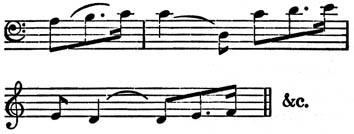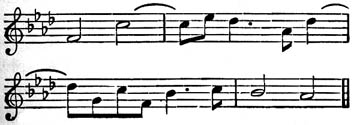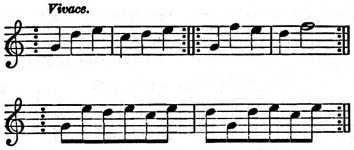Music with Ease > Operas of Richard Wagner > Music of Tristan and Isolde (Wagner)
The Music of 'Tristan and Isolde'
(German title: Tristan und Isolde)
An Opera by Richard Wagner
When "Tristan" was first produced, and for long after, the complaint that it lacked melody was loudly heard everywhere. Its endless harmonic "melos" was too much for the amateurs, nay for the professionals of that time. There are some who, even to-day, think that the harmonic intensity of the work is excessive; and one can at least understand that position. The extreme chromatic nature of the harmony cannot fail to be remarked even by the most untutored. In the Prelude to the First Act, for example, not a single concord is heard; and that is true of the score throughout, for many pages at a time. There is only one "full close" in the entire work -- at the end of Act I. But all this only adds to the "intense" or emotional character of the music and the unbroken continuity of the drama, the musical beauty of which has become clearer as the perception of harmony has become more keen. What at first seemed jumbled and meaningless, is now seen to be well ordered, designed by a master-hand; a tonal tapestry of superb web and woof.
Built up of representative themes; almost destitute of concerted music; with continued declamation for the voices, and an entire absence of form, as the term is generally understood, "Tristan" is essentially a distinctive and individual thing. Here, more than in any of his works, Wagner freed himself from all operatic convention, all restrictions of historical detail. In a letter of 1860, addressed to Francis Villot, he says of "Tristan": "Upon that work I consent to your making the severest claims deducible from my theoretic premises; not because I formed it on my system, for every theory was clean forgotten by me; but since here I moved with fullest freedom and the most utter disregard of every theoretic scruple, to such an extent that during the working out I myself was unaware how far I had outstripped my system."
Thus, then, in "Tristan" we have Wagner’s art system stretched to its utmost limits, and even beyond. The complexity of the score, technically considered, is simply marvelous. Yet, such is the skill of the master, that the resultant effect is appreciable in the highest degree to the most technically uninformed listener. No listener need burden his memory with the various "motives" in the stupendous score. Many of them, as Mr. W. J. Henderson’s admirable analysis has shown, are thematic developments of phrases first heard in germinal form, and it is in the overwhelming eloquence of these developments that the power of the score is largely to be found. The resultant effect is -- or should be -- like the resultant effect of, say, a grand specimen of cathedral architecture. The details are there, but they are sunk in contemplation of the general impression. "Tristan and Isolde" adapts itself to the individual needs and inner feelings of a thousand listeners, every one of whom may be quite unlearned in the theory of the musical art. It searches the nerves and mirrors the emotions of men and women as perhaps no other music in the world does.
The music of the First Act is all more or less redolent of the sea. The wonderful Prelude (which Berlioz declared was an enigma to him) works out the principal "motive" -- the Isolde motive -- of the drama into various shapes of melodious beauty. It is a theme of striking impressiveness; a haunting, emotion-laden, ineffably sad phrase, in which Wagner has painted with his master-touch the feverish longing and the deep devotion of love --

Extensive use is made of this theme throughout; moreover, many of the other motives are derived from it, or bear a close resemblance to it. It appears whenever the composer wishes to suggest the idea of the love-potion or of irresistible passion. What may be called the "glance" motive is also accorded a prominent place, alike in this Prelude and in the drama itself --

This theme, developed at length in the Prelude, is used again when the lovers exchange that meaning glance by which they learn of the passion that dominates them before the drinking of the philtre. Every bar, nay, every note of this Prelude seems weighted with emotion; its restless, mordant tones laying bare, as it were, a whole world of love and longing. No more fitting introduction to the glowing musical picture of love and despair which Wagner has painted here can well be imagined.
After the introduction, the quaint, peaceful song of the sailor as he sings of his absent Irish lass attracts attention. There is some very arresting music accompanying Tristan’s first interview with Isolde, beginning with an orchestral passage voicing the heroism and the fate of the hero -- a passage of really extraordinary power. The theme here is solemn and majestic, opening with a long note which "swells out until it leaps upward to die away in a wail." The song of the seamen, again, as they reduce sail, is strongly illuminative of the atmosphere in which the whole act is enshrined: the breezy, briny atmosphere of the ocean, with its running billows and is flying foam. The lyrical parts of the opera are, all through, of exceptional, some of almost resistless beauty, giving the lie direct to the long-exploded notion that Wagner was a composer totally lacking in the gift of melody.
The Prelude to the unutterably voluptuous Second Act begins with startling abruptness. It forecasts with rare skill the events and feelings which are to immediately follow: the eager anticipation of the lovers (oh, how eager!); the soft, sweet atmosphere of the summer night, with the rustling of the leaves and the gentle murmurings of the stream. The "Day" motive strikes the note of tragedy --

This theme is employed with great frequency throughout the drama.
Nothing could well surpass the ardent fervour and heat of this Act as expressed in the music, with its rapturous airs and its incomparable love-duet. For pathos and sweetness, it is unequalled in the whole range of operatic literature. Its long-drawn melting measures breathe all the pulsing and all the languors of consuming desire. It is of magical beauty -- superb! Even the moonlight appears to be charged with melody! The Act, to speak of it as a whole, contains some of the finest effects in the musical delineation of love that have ever been produced. And when it is all over -- after all this "surging music" has raked our emotions -- the close comes with a single chord, as the curtain falls! Simple it is, and yet how strikingly effective!
The short Prelude to the Third Act, well known in the concert-room, is of an intensely mournful character, with its suggestions of bitter grief and loneliness. Here the Isolde motive, already quoted, assumes weird and lugubrious forms, and the effect is so poignant as to be almost painful. A splendid passage of ascending thirds enunciated by the violins, can hardly be missed by any attentive listener.
After the Prelude, one notes first the melody piped out by the shepherd-the saddest melody ever written: an afflicting and even "nightmarish" strain, heard again and again in the score, most eerily during the delirious ravings of the dying Tristan --

This profoundly dolorous air, played on the Cor Anglais, floats woefully and wearily through the hot, close, breathless atmosphere. Presently the lancinating melody changes to the following lively forms, as Isolde’s ship is sighted --

There is a lovely bit of music to accompany Tristan’s description of the ship which is bearing Isolde towards him. The "gentle swaying" figure of the horns and the delicious melody given to the voice combine to make an effect of richness and tenderness which, once heard, can never be forgotten. But Isolde’s swan-song, the well-known "Liebestod," is the masterpiece of the drama. That is the most superlatively beautiful of all Wagner’s creations -- one of the most consummate pieces of music in existence, indeed. This number is identical with the latter portion of the great love-duet in the Second Act, a magnificent climax and coda being added. Wagner’s idea obviously was to produce a pensive echo of the former happy union of the lovers; to call up a tristful remembrance of lost bliss. It is a marvelous scene altogether.
Of the gorgeous orchestration it is hardly possible to speak. To convey any idea of that "weltering symphonic mass" in words is a task which has baffled scores of writers. Only when it is heard can its splendour be appreciated to the full. A distinguished American critic may be drawn upon to express what so many have felt and have yet been unable to express. He says: "If a painter should discover and use a new spectrum with colours never before seen by mortal eyes, he would do for the sense of sight what Wagner has done in ‘Tristan’ for the ear. What a marvellous variety of tone-colours, many of them entirely new on the musical palette, has he lavished on this score! Yet all this sensuous beauty is placed entirely in the service of the dramatic emotion which it is intended to intensify." No writer can better these words. That glorious web of melody, woven from the individual orchestral parts -- who shall speak of it fittingly? Louis Ehlert, in one of his letters, says: "When in the Second Act Isolde is awaiting her lover, when the orchestra throbs with a thousand pulses and every nerve becomes a sounding tone, I am no longer the man I am through the rest of the year, nor am I artistically and morally a responsible being: I am a Wagnerian." Thousands who have listened to the music of "Tristan" have felt just like that. And no wonder! As Mr. J. F. Runciman has truly said, there never was music poured out at so white a white heat. It is music written in the most modern, most pungent, and raciest vernacular, with utter impatience of style, of writing merely in an approved manner. It is beyond criticism -- of all Wagner’s works that which most arrests and enchains the imagination.
Music With Ease | About Us | Contact Us | Privacy | Sitemap | Copyright | Terms of Use © 2005-23 musicwithease.com. All Rights Reserved. |
